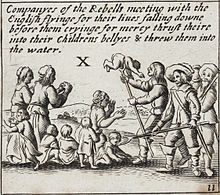Eleven years war
| Irish Confederate Wars or Eleven Years' War |
||||||||
|---|---|---|---|---|---|---|---|---|
| Part of the Wars of the Three Kingdoms | ||||||||
 Václav Hollar's engraving of supposed atrocities committed by Irish Catholics in the war of 1641 |
||||||||
|
||||||||
| Belligerents | ||||||||
|
(allied with Royalists 1648–1650) |
|
English and Scottish Royalists (allied with Irish Confederates 1648–1650) |
||||||
| Commanders and leaders | ||||||||
| Confederate Supreme Council, Owen Roe O'Neill (in Ulster), Thomas Preston (in Leinster), Garret Barry (in Munster), John Burke (in Connacht) |
Murrough O'Brien (1644–47), Michael Jones (1647–49), Oliver Cromwell (1649–50), Henry Ireton (May 1650–Nov 1651), Charles Fleetwood (Nov 1651–Apr 1653), Robert Monro (Scottish Covenanter in support of Parliament 1642–48) |
James Butler (1641–Dec 1650), Ulick Burke (Dec 1650–Apr 1653), George Munro (Scottish Covenanter in support of Royalists 1648–50) |
||||||
| Strength | ||||||||
| up to 60,000 (incl. guerrillas), but only about 20,000 at any one time | ~10,000 (before 1649), ~30,000 New Model Army troops (after 1649) |
varying | ||||||
| Casualties and losses | ||||||||
| unknown – over 25,000 battlefield casualties and over 200,000 civilians from war-related famine or disease, ~12,000 transported to West Indies (by 1660) |
8,000 New Model Army soldiers killed, more from locally raised units, thousands of Scottish Covenanters killed |
|||||||
|
|
||||||||
The Irish Confederate Wars, also called the Eleven Years' War (derived from the Irish language name Cogadh na hAon Bhliana Déag), took place in Ireland between 1641 and 1653. It was the Irish theatre of the Wars of the Three Kingdoms – a series of civil wars in the kingdoms of Ireland, England and Scotland (all ruled by Charles I). The conflict in Ireland essentially started by pitting the native Irish Catholics against English and Scottish Protestant colonists and their supporters, and ended with Royalists, Irish Catholics and Scottish Presbyterians fighting the ultimate winners, the English Parliament. It was both a religious and an ethnic conflict – fought over who would govern Ireland, whether it would be governed from England, which ethnic and religious group would own most of the land, and which religion would predominate in the country. It was the most destructive conflict in Irish history.
The war in Ireland began with the Rebellion of 1641 in Ulster in October, during which many Scots and English Protestant settlers were killed. The rebellion spread throughout the country and at Kilkenny in 1642 the Association of The Confederate Catholics of Ireland was formed to organise the Catholic war effort. The Confederation was essentially an independent state and was a coalition of all shades of Irish Catholic society, both Gaelic and Old English. The Irish Confederates professed to side with the English Cavaliers during the ensuing civil wars, but mostly fought their own war in defence of the Catholic landed class' interests.
...
Wikipedia
